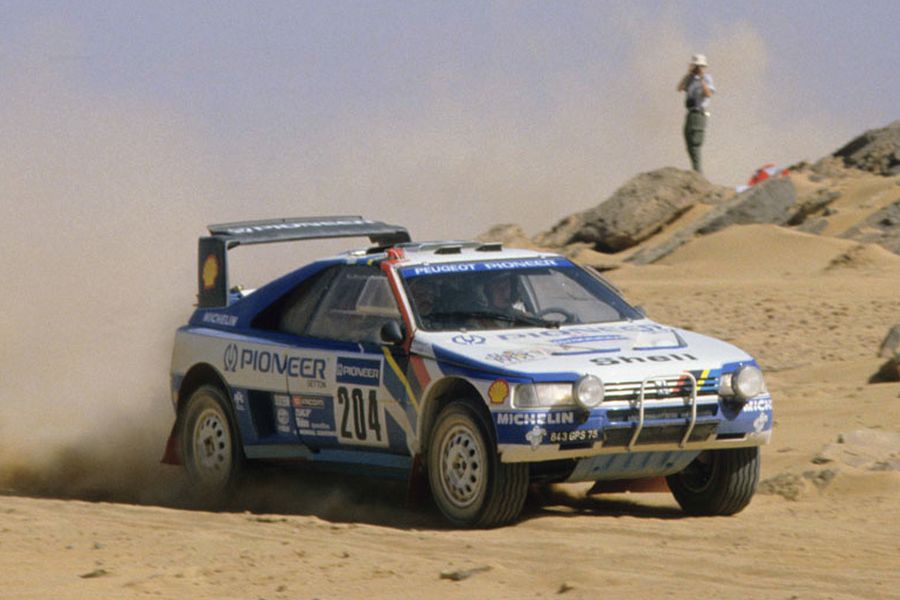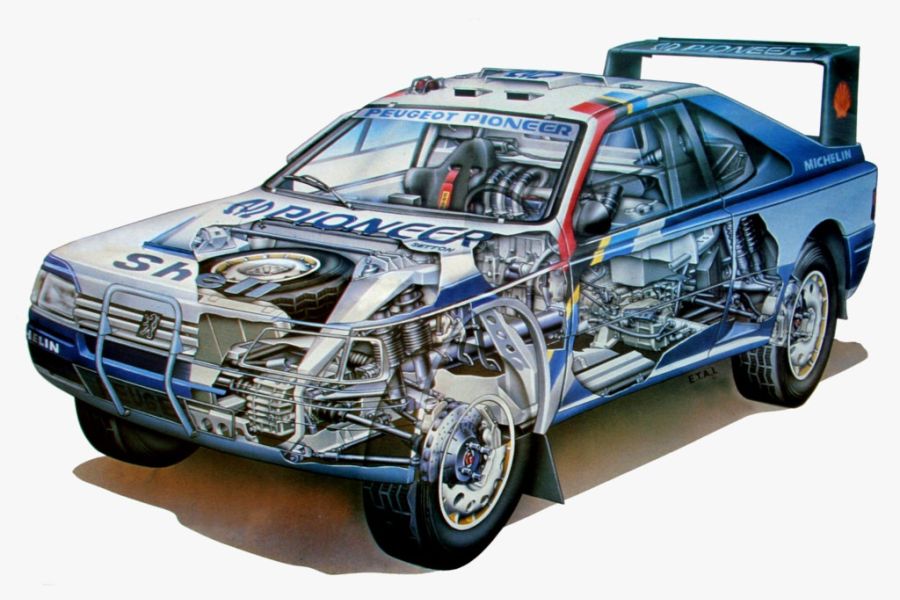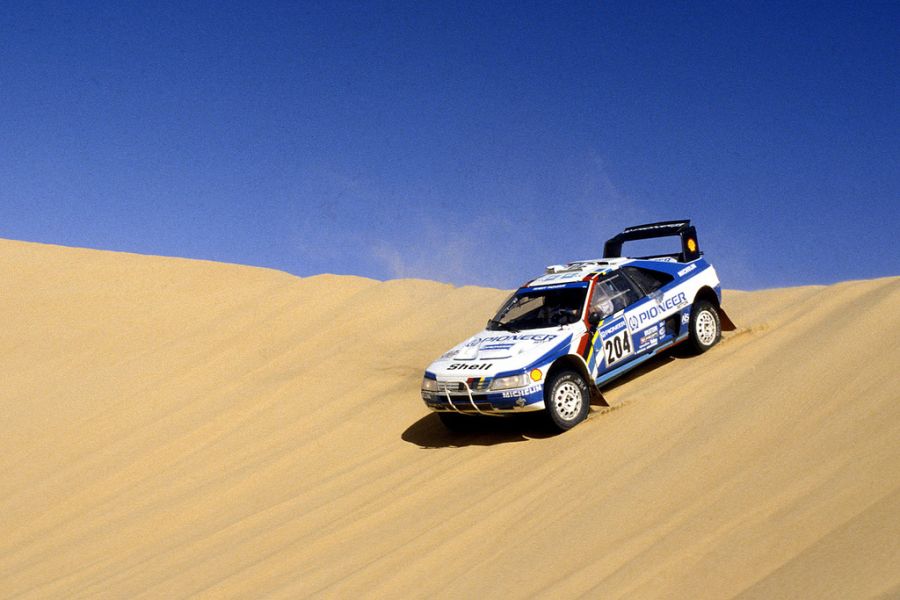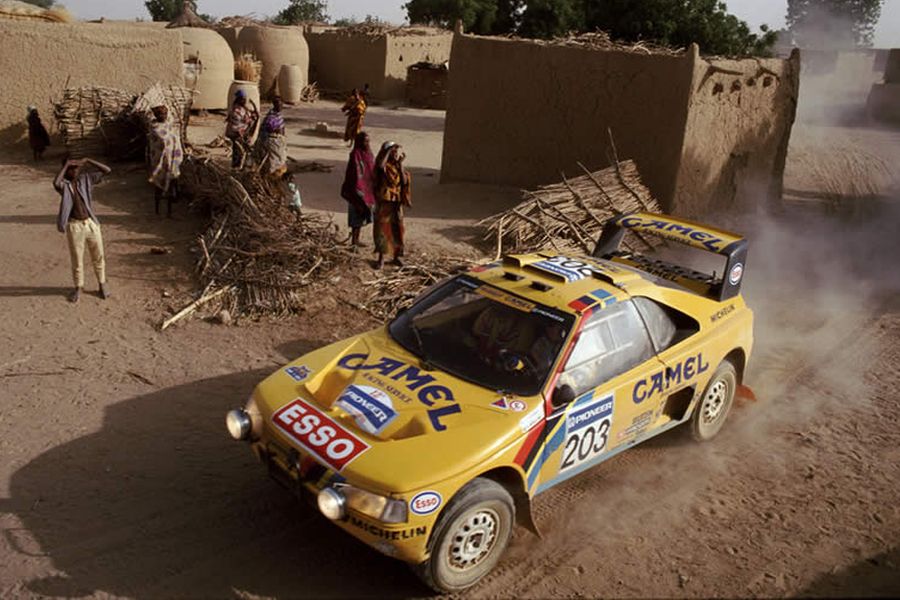Peugeot 405 Turbo 16 - Climb Dancer and Desert Warrior
Peugeot 405 Turbo 16 (or 405 T16) is the legendary race car which earned two consecutive Dakar Rally victories for the French manufacturer in 1989 and 1990, driven by Ari Vatanen. It were the last two wins before Peugeot’s return to Dakar in 2015. Prior to historical wins in the African desert, 405 T16 conquered the Pikes Peak International Hill Climb in 1988, also driven by Ari Vatanen, who set the new track record.

Peugeot 405 Turbo 16 at Paris – Dakar Rally
Peugeot 405 T16 was a successor of breathtaking 205 Turbo 16
The Peugeot 405 T16 is the successor of the famous Peugeot 205 Turbo 16, which marked the last years of the Group B period in the World Rally Championship, winning two manufacturers’ world titles. After the Group B was banned, 205 T16 was transferred to rally-raid stages, earning two wins at Dakar Rally in 1987 and 1988.
In 1987, the production version of Peugeot 405 was introduced, immediately gaining a big success on the market. It was voted European Car of the Year for 1988. The racing model 405 Turbo 16, which was a derivation of coupe-designed 405 and technology from 205 T16, was introduced for its debut at 1988 Dakar Rally, alongside winning-model car the previous year 205 T16.

Peugeot 405 Turbo 16 cutaway
Mid-engined turbo-powered beast for the hill and desert
Peugeot 405 Turbo 16 was built in mid-engine configuration, featuring constant four-wheel-drive system with electronically adjustable center differential. The 405 T16 was a unique car of its time because it was the only car with the four-wheel steering system.
The 405’s body was made of carbon-kevlar, wrapped over a completely new chassis made of sheet steel and tubular steel. The engine sat very low in front of the right rear wheel with the turbocharger on the opposite side.
The powertrain was a 1905cc 4-cylinder petrol engine with Garrett turbocharger, which increased a power to about 650 hp. As the weight of a car was just 950 kg, it has an incredible power-to-weight ratio of 684 hp per ton. The Grand Raid version of the 405 T16 was slightly different. Except aerodynamics, it has less power (about 400hp) and bigger mass (1300 kg).
Debut for 405 T16 at 1988 Paris – Dakar Rally
Juha Kankkunen has won the Paris – Dakar Rally in 1988 with 205 T16, Ari Vatanen was in the #204 Peugeot 405 T16. His car disappeared at the beginning of Stage 13. He was disqualified because he doesn’t arrive at his departure line within 30 minutes. Once the vehicle was found, he finished 8th in the special stage but remained suspended.
Video : Ari Vatanen’s Climb Dance
Two consecutive wins for 405 Turbo 16 at Pikes Peak
A few months later, Peugeot drivers traveled to Colorado, USA, to break a dominance of Audi Quattro at the famous Pikes Peak International Hill Climb. After six consecutive Audi wins, Vatanen was not only taking the victory for Peugeot but he also broke the track record, setting the new fastest time of 10 minutes 47.220 seconds, half a second faster than Walter Rohrl a year earlier with Audi Sport Quattro E2.
Vatanen’s victory at Pikes Peak is one of the most memorable moments from that race because a year later Jean-Louis Mourey released a short promotional film, titled Climb Dance, which became one of the most popular racing movies in a history of motorsport. At 1989 Pikes Peak race, Peugeot clinched another victory. This time, the winning driver was Robby Unser.

Peugeot 405 T16 scored two wins at Dakar Rally
Two wins at Dakar Rally before withdrawing
In 1989, Ari Vatanen and Jacky Ickx were driving the 405 T16 at Dakar Rally. Vatanen scored his second victory and the first win for that car. As Vatanen and Ickx were tied in the lead, the team boss Jean Todt decided a winner by tossing a ten-franc coin. Vatanen had more luck and he won the event.
In 1990, Vatanen scored one more Paris – Dakar victory for Peugeot 405 T16. This time, he won more comfortably ahead of teammate Bjorn Waldegard in another 405 T16. After that victory, with a total of four wins on its account, Peugeot withdrew from competition, focusing to the sports-prototypes championship.

Peugeot 405 T16 at Pikes Peak
Peugeot 405 Turbo 16 technical specifications
Length: 4250 mm
Width: 1760 mm
Weight: 950 kg (Grand Raid 1300 kg)
Wheelbase: 2888 mm
Track (front and rear): 1453 mm
Chassis: Central space frame made from stamped sheet metal and steel tubes;
front and rear space frames from steel tubes
Body: Composite fiber bodywork
Engine: 1905cc, 4 cylinder 16v XU9T, mounted transversely
Power/torque: 650 hp/685 Nm (Grand Raid: 400hp/490 Nm)
Transmission: 6-speed manual gearbox
Suspension: Double wishbone front and rear suspension with 1 coilover damper per corner and anti-rollbars
Braking system: Front and rear ventilated brake disks 327mm with AP Racing 4 piston calipers
Tires: front 225/50-16 (on track Michelin 25/64-16), rear 270/45-16 (on track Michelin 26/64-16)
Grand Raid tires Michelin 18/73-16
Photos: McKlein, motorsportretro.com,







